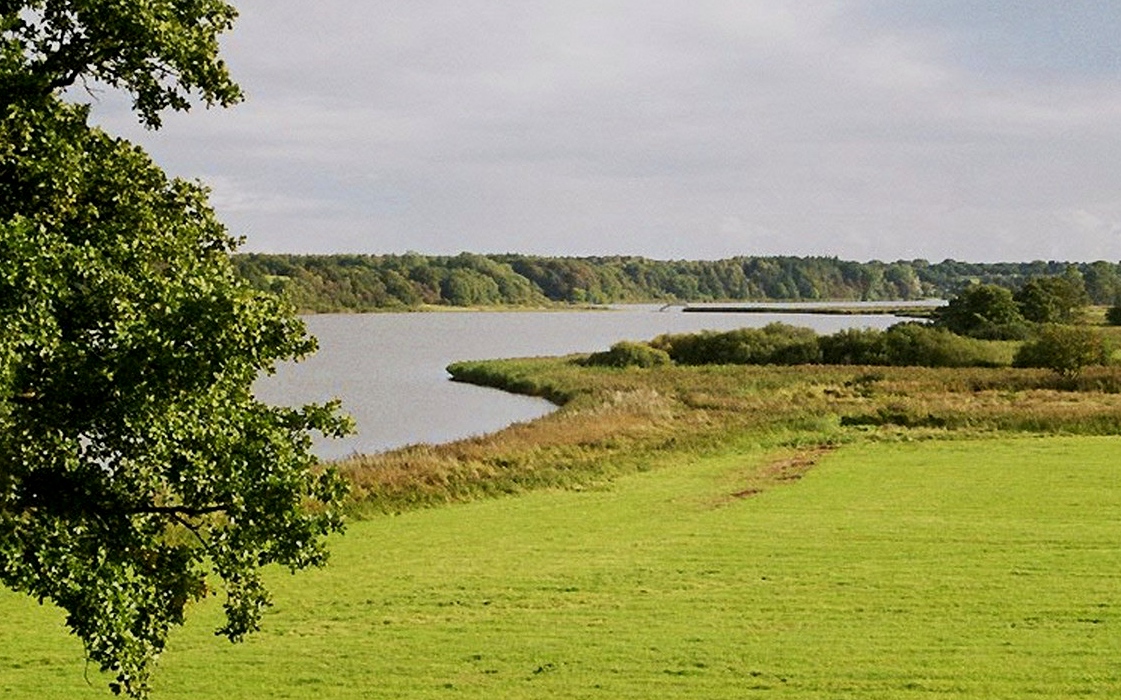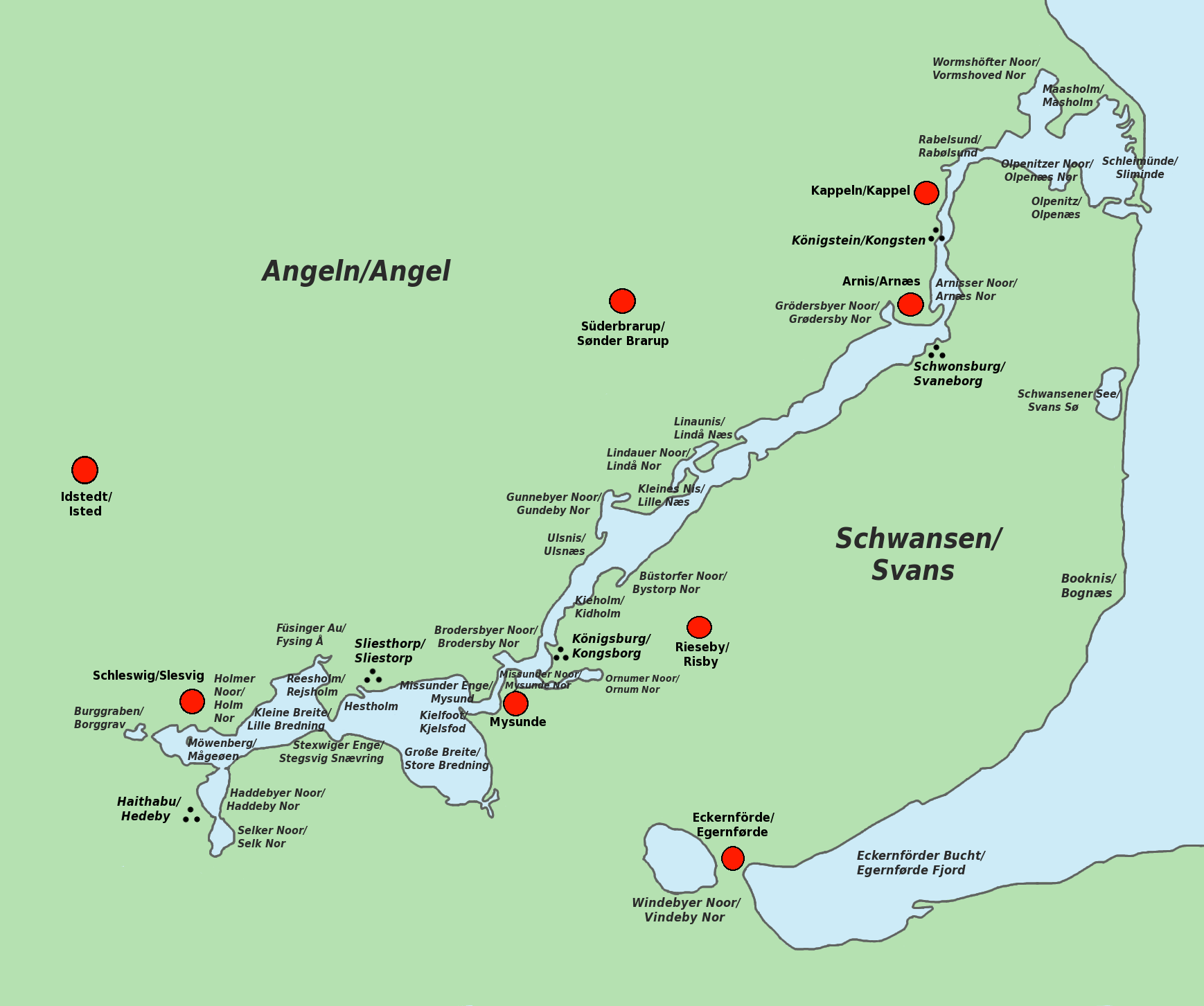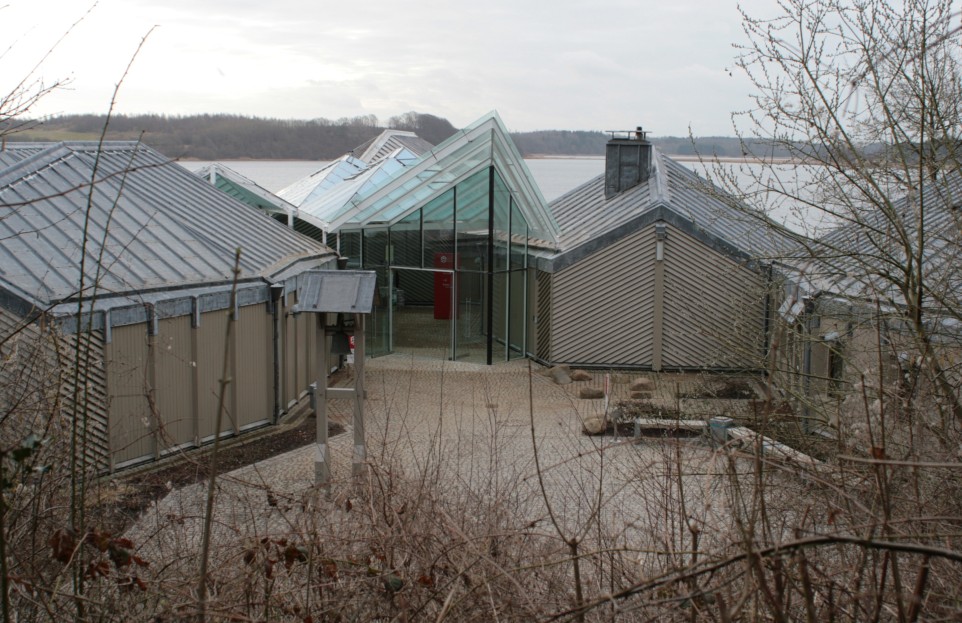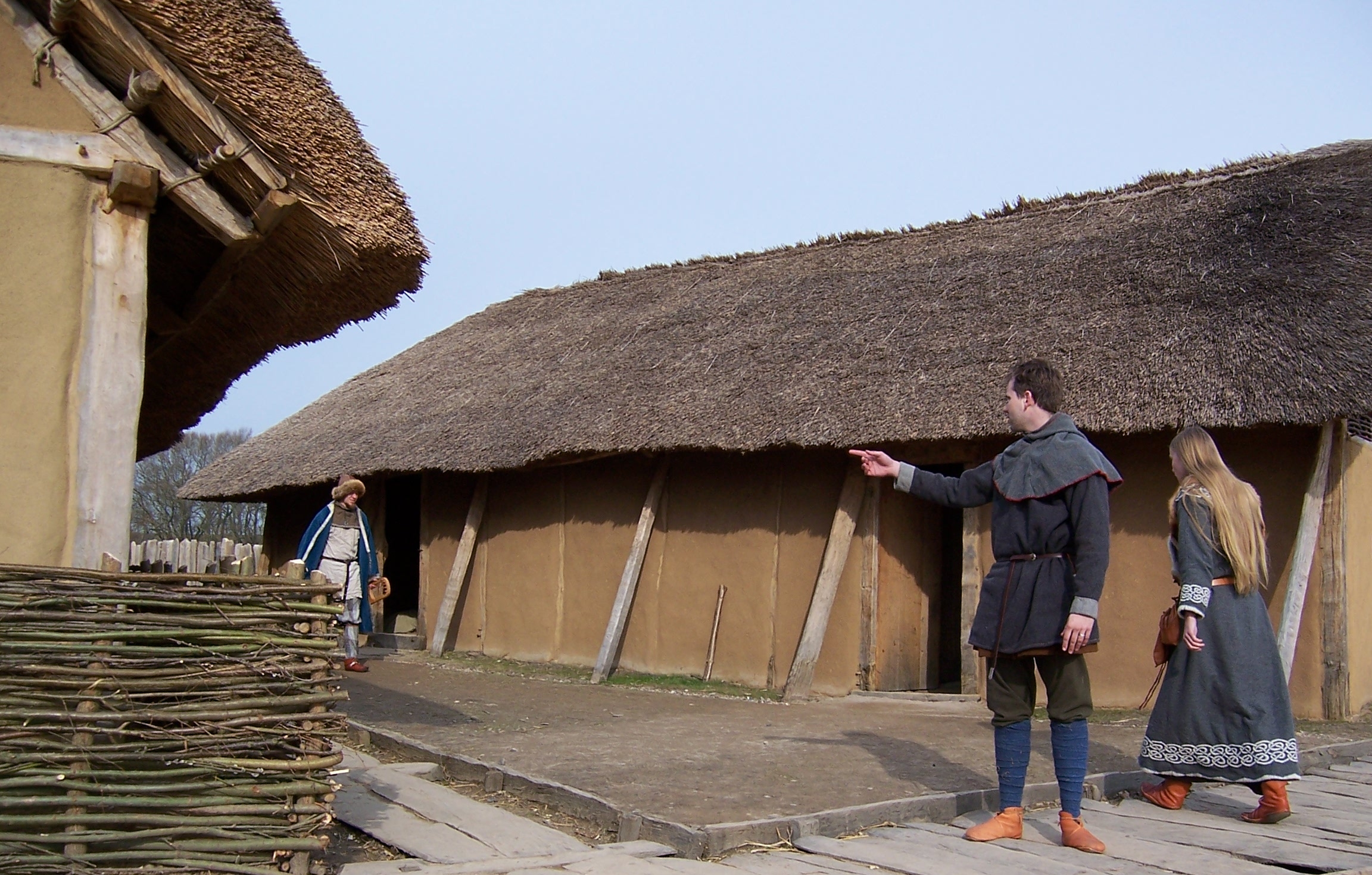Haithabu Gewandfibel Borrestil.JPG on:
[Wikipedia]
[Google]
[Amazon]
Hedeby (, Old Norse ''Heiðabýr'',



 The Old Norse name ''Heiða-býr'' simply translates to "heath-settlement" (''heiðr'' " heath" and ''býr'' = "yard; settlement, village, town"). The name is recorded in numerous spelling variants.
* ''Heiðabýr'' is the reconstructed name in standard Old Norse, also anglicized as ''Heithabyr''.
* The Stone of Eric, a 10th-century Danish runestone with an inscription mentioning ᚼᛅᛁᚦᛅ᛭ᛒᚢ (''haiþa bu''), found in 1796.Project Samnordisk Runtextdatabas Svensk
The Old Norse name ''Heiða-býr'' simply translates to "heath-settlement" (''heiðr'' " heath" and ''býr'' = "yard; settlement, village, town"). The name is recorded in numerous spelling variants.
* ''Heiðabýr'' is the reconstructed name in standard Old Norse, also anglicized as ''Heithabyr''.
* The Stone of Eric, a 10th-century Danish runestone with an inscription mentioning ᚼᛅᛁᚦᛅ᛭ᛒᚢ (''haiþa bu''), found in 1796.Project Samnordisk Runtextdatabas Svensk
-
/ref> *Old English ''æt Hæðum'', from Ohthere of Hålogaland, Ohthere's account of his travels to

 After the settlement was abandoned, rising waters contributed to the complete disappearance of all visible structures on the site. It was even forgotten where the settlement had been. This proved to be fortunate for later archaeological work at the site.
Archaeological work began at the site in 1900 after the rediscovery of the settlement. Excavations were conducted for the next 15 years. Further excavations were carried out between 1930 and 1939. Archaeological work on the site was productive for two main reasons: that the site had never been built on since its destruction some 840 years earlier, and that the permanently waterlogged ground had preserved wood and other perishable materials. After the Second World War, in 1959, archaeological work was started again and has continued intermittently ever since. The embankments surrounding the settlement were excavated, and the harbour was partially dredged, during which the wreck of a Viking ship was discovered. Despite all this work, only 5% of the settlement (and only 1% of the harbour) has as yet been investigated.
The most important finds resulting from the excavations are now on display in the adjoining Haithabu Museum.
After the settlement was abandoned, rising waters contributed to the complete disappearance of all visible structures on the site. It was even forgotten where the settlement had been. This proved to be fortunate for later archaeological work at the site.
Archaeological work began at the site in 1900 after the rediscovery of the settlement. Excavations were conducted for the next 15 years. Further excavations were carried out between 1930 and 1939. Archaeological work on the site was productive for two main reasons: that the site had never been built on since its destruction some 840 years earlier, and that the permanently waterlogged ground had preserved wood and other perishable materials. After the Second World War, in 1959, archaeological work was started again and has continued intermittently ever since. The embankments surrounding the settlement were excavated, and the harbour was partially dredged, during which the wreck of a Viking ship was discovered. Despite all this work, only 5% of the settlement (and only 1% of the harbour) has as yet been investigated.
The most important finds resulting from the excavations are now on display in the adjoining Haithabu Museum.
University of Kiel's Archaeological Film Project.
' * Most publications on Hedeby are in German. See '' Wikipedia's German-language article on Hedeby.'' *
Website of the Haithabu Viking Museum
Flickr Photo Gallery: Viking houses and museum
{{Authority control Archaeological sites in Germany Former populated places in Denmark Former populated places in Germany History of Schleswig-Holstein Viking Age populated places World Heritage Sites in Germany
German
German(s) may refer to:
* Germany (of or related to)
**Germania (historical use)
* Germans, citizens of Germany, people of German ancestry, or native speakers of the German language
** For citizens of Germany, see also German nationality law
**Ger ...
''Haithabu'') was an important Danish
Danish may refer to:
* Something of, from, or related to the country of Denmark
People
* A national or citizen of Denmark, also called a "Dane," see Demographics of Denmark
* Culture of Denmark
* Danish people or Danes, people with a Danish ance ...
Viking Age (8th to the 11th centuries) trading settlement near the southern end of the Jutland Peninsula, now in the Schleswig-Flensburg district of Schleswig-Holstein, Germany. It is the most important archaeological site in Schleswig-Holstein. Around 965, chronicler Abraham ben Jacob visited Hedeby and described it as, "a very large city at the very end of the world's ocean."
The settlement developed as a trading centre at the head of a narrow, navigable inlet known as the Schlei, which connects to the Baltic Sea. The location was favorable because there is a short portage of less than 15 km to the Treene River
The Treene ( da, Trenen) is a river, hydrologically and nominally long, in the north of Schleswig-Holstein, Germany. It is a right-bank tributary of the River Eider. It starts in northern Angeln, southeast of Flensburg, and flows mainly south-sou ...
, which flows into the Eider with its North Sea estuary, making it a convenient place where goods and ships could be pulled on a corduroy road
A corduroy road or log road is a type of road or timber trackway made by placing logs, perpendicular to the direction of the road over a low or swampy area. The result is an improvement over impassable mud or dirt roads, yet rough in the bes ...
overland for an almost uninterrupted seaway between the Baltic and the North Sea and avoid a dangerous and time-consuming circumnavigation of Jutland, providing Hedeby with a role similar to later Lübeck.
Hedeby was the second largest Nordic town during the Viking Age, after Uppåkra in present-day southern Sweden,
The city of Schleswig was later founded on the other side of the Schlei. Hedeby was abandoned after its destruction in 1066.
Hedeby was rediscovered in the late 19th century and excavations began in 1900. The Hedeby Museum was opened next to the site in 1985. Because of its historical importance during the Viking Age and exceptional preservation, Hedeby and the nearby defensive earthworks of the Danevirke were inscribed on the UNESCO World Heritage List in 2018.
Hedeby is mentioned in Hans Christian Andersen's fairy tale "The Marsh King's Daughter."
Name



 The Old Norse name ''Heiða-býr'' simply translates to "heath-settlement" (''heiðr'' " heath" and ''býr'' = "yard; settlement, village, town"). The name is recorded in numerous spelling variants.
* ''Heiðabýr'' is the reconstructed name in standard Old Norse, also anglicized as ''Heithabyr''.
* The Stone of Eric, a 10th-century Danish runestone with an inscription mentioning ᚼᛅᛁᚦᛅ᛭ᛒᚢ (''haiþa bu''), found in 1796.Project Samnordisk Runtextdatabas Svensk
The Old Norse name ''Heiða-býr'' simply translates to "heath-settlement" (''heiðr'' " heath" and ''býr'' = "yard; settlement, village, town"). The name is recorded in numerous spelling variants.
* ''Heiðabýr'' is the reconstructed name in standard Old Norse, also anglicized as ''Heithabyr''.
* The Stone of Eric, a 10th-century Danish runestone with an inscription mentioning ᚼᛅᛁᚦᛅ᛭ᛒᚢ (''haiþa bu''), found in 1796.Project Samnordisk Runtextdatabas Svensk-
Rundata
The Scandinavian Runic-text Data Base ( sv, Samnordisk runtextdatabas) is a project involving the creation and maintenance of a database of runic inscriptions. The project's goal is to comprehensively catalog runestones in a machine-readable way f ...
entry for DR /ref> *Old English ''æt Hæðum'', from Ohthere of Hålogaland, Ohthere's account of his travels to
Alfred the Great
Alfred the Great (alt. Ælfred 848/849 – 26 October 899) was King of the West Saxons from 871 to 886, and King of the Anglo-Saxons from 886 until his death in 899. He was the youngest son of King Æthelwulf and his first wife Osburh, who bot ...
in the Old English Orosius
Paulus Orosius (; born 375/385 – 420 AD), less often Paul Orosius in English, was a Roman priest, historian and theologian, and a student of Augustine of Hippo. It is possible that he was born in '' Bracara Augusta'' (now Braga, Portugal), t ...
.
* ''Hedeby'', the modern Danish spelling, also most commonly used in English.
* ''Haddeby
Haddeby is an ''Amt'' ("collective municipality") in the district of Schleswig-Flensburg, in Schleswig-Holstein, Germany. It is situated on the south bank of the Schlei, southeast of Schleswig. The seat of the ''Amt'' is in Busdorf. It was named af ...
'' is the Low German
:
:
:
:
:
(70,000)
(30,000)
(8,000)
, familycolor = Indo-European
, fam2 = Germanic
, fam3 = West Germanic
, fam4 = North Sea Germanic
, ancestor = Old Saxon
, ancestor2 = Middle L ...
form, also the name of the administrative district formed in 1949 and named for the site; in 1985, the district introduced a coat of arms featuring a bell with a runic inscription reading ᚼᛁᚦᛅ᛬ᛒᚢ (''hiþa:bu'').
* ''Haithabu'' is the modern German spelling used when referring to the historical settlement; this spelling represents the transliteration of the name as found in the Stone of Eric inscription; it was introduced among other variants in antiquarian literature in the 19th century and has since become the standard German name of the settlement.
Sources from the 9th and 10th century AD also attest to the names ''Sliesthorp'' and ''Sliaswich'' (cf. '' -thorp'' vs. ''-wich
A "-''wich'' town" is a settlement in Anglo-Saxon England characterised by extensive artisanal activity and tradean " emporium".
The name is derived from the Anglo-Saxon suffix , signifying "a dwelling or fortified place".
Such settlements were u ...
''), and the town of Schleswig still exists 3 km north of Hedeby. However, Æthelweard Æthelweard, also spelled Ethelweard, Aethelweard, Athelweard, etc., is an Anglo-Saxon male name. It may refer to:
* King Æthelweard of the Hwicce (''fl''. 7/8th century)
* King Æthelweard of East Anglia (''fl.'' mid-9th century)
* Æthelweard (s ...
claimed in his Latin translation of the Anglo-Saxon Chronicle
The ''Anglo-Saxon Chronicle'' is a collection of annals in Old English, chronicling the history of the Anglo-Saxons. The original manuscript of the ''Chronicle'' was created late in the 9th century, probably in Wessex, during the reign of Alf ...
that the Saxons used ''Slesuuic'' and the Danes ''Haithaby'' to refer to the same town.
History
Origins
Hedeby is first mentioned in the Frankish chronicles ofEinhard
Einhard (also Eginhard or Einhart; la, E(g)inhardus; 775 – 14 March 840) was a Frankish scholar and courtier. Einhard was a dedicated servant of Charlemagne and his son Louis the Pious; his main work is a biography of Charlemagne, the ''Vita ...
(804) who was in the service of Charlemagne,
but was probably founded around 770. In 808 the Danish king Godfred
Gudfred was a ninth century Danish king who reigned from at least 804 to 810. Alternate spellings include ''Godfred'' (Danish), ''Göttrick'' (German), ''Gøtrik'' (Danish), ''Gudrød'' (Danish), and ''Godofredus'' (Latin). He stands at the thres ...
(Lat. Godofredus) destroyed a competing Slav trade centre named Reric
Reric or Rerik was one of the Viking Age multi-ethnic Slavic- Scandinavian emporia on the southern coast of the Baltic Sea, located near Wismar in the present-day German state of Mecklenburg-VorpommernOle Harck, Christian Lübke, Zwischen Reric ...
, and it is recorded in the Frankish chronicles that he moved the merchants from there to Hedeby. This may have provided the initial impetus for the town to develop. The same sources record that Godfred strengthened the Danevirke, an earthen wall that stretched across the south of the Jutland peninsula. The Danevirke joined the defensive walls of Hedeby to form an east–west barrier across the peninsula, from the marshes in the west to the Schlei inlet leading into the Baltic in the east.
The town itself was surrounded on its three landward sides (north, west, and south) by earthworks. At the end of the 9th century the northern and southern parts of the town were abandoned for the central section. Later a 9-metre (29-ft) high semi-circular wall was erected to guard the western approaches to the town. On the eastern side, the town was bordered by the innermost part of the Schlei inlet and the bay of Haddebyer Noor.
Timeline
Rise
Hedeby became a principal marketplace because of its geographical location on the major trade routes between the Frankish Empire and Scandinavia (north-south), and between theBaltic
Baltic may refer to:
Peoples and languages
* Baltic languages, a subfamily of Indo-European languages, including Lithuanian, Latvian and extinct Old Prussian
*Balts (or Baltic peoples), ethnic groups speaking the Baltic languages and/or originati ...
and the North Sea (east-west). Between 800 and 1000 the growing economic power of the Vikings led to its dramatic expansion as a major trading centre. Along with Birka and Schleswig, Hedeby's prominence as a major international trading hub served as a foundation of the Hanseatic League
The Hanseatic League (; gml, Hanse, , ; german: label=Modern German, Deutsche Hanse) was a medieval commercial and defensive confederation of merchant guilds and market towns in Central and Northern Europe. Growing from a few North German to ...
that would emerge by the 12th century.
The following indicate the importance achieved by the town:
* The town was described by visitors from England ( Wulfstan - 9th century) and the Mediterranean ( Al-Tartushi - 10th century).
* Hedeby became the seat of a bishop (948) and belonged to the Archbishopric of Hamburg and Bremen
Bremen (Low German also: ''Breem'' or ''Bräm''), officially the City Municipality of Bremen (german: Stadtgemeinde Bremen, ), is the capital of the German state Free Hanseatic City of Bremen (''Freie Hansestadt Bremen''), a two-city-state consis ...
.
* The town minted its own coins (from 825).
* Adam of Bremen (11th century) reports that ships were sent from this ''portus maritimus'' to Slavic lands, to Sweden
Sweden, formally the Kingdom of Sweden,The United Nations Group of Experts on Geographical Names states that the country's formal name is the Kingdom of SwedenUNGEGN World Geographical Names, Sweden./ref> is a Nordic country located on ...
, Samland (''Semlant'') and even Greece.
A Swedish dynasty founded by Olof the Brash
Olof was a king who, according to a late source, ruled in Denmark in about 900 after usurping power. Evidence for his historicity is only circumstantial, since he belongs to a period of Danish history when very little is known from textual source ...
is said to have ruled Hedeby during the last decades of the 9th century and the first part of the 10th century. This was told to Adam of Bremen by the Danish king Sweyn Estridsson
Sweyn Estridsson Ulfsson ( on, Sveinn Ástríðarson, da, Svend Estridsen; – 28 April 1076) was King of Denmark (being Sweyn II) from 1047 until his death in 1076. He was the son of Ulf Thorgilsson and Estrid Svendsdatter, and the grandson ...
, and it is supported by three runestones found in Denmark. Two of them were raised by the mother of Olof's grandson Sigtrygg Gnupasson
Sigtrygg Gnupasson was semi-legendary a king of Denmark of the House of Olaf who ruled in the 10th century, according to Adam of Bremen.
Sigtrygg was son of Gnupa and the Danish noblewoman Asfrid. According to Adam, he became a Danish king duri ...
. The third runestone, discovered in 1796, is from Hedeby, the '' Stone of Eric'' ( sv, Erikstenen). It is inscribed with Norwegian-Swedish runes. It is, however, possible that Danes also occasionally wrote with this version of the younger futhark.
Lifestyle
Life was short and crowded in Hedeby. The small houses were clustered tightly together in a grid, with the east–west streets leading down to jetties in the harbour. People rarely lived beyond 30 or 40, and archaeological research shows that their later years were often painful due to crippling diseases such as tuberculosis. Al-Tartushi, a late 10th-century traveller from al-Andalus, provides one of the most colourful and often quoted descriptions of life in Hedeby. Al-Tartushi was from Cordoba in Spain, which had a significantly more wealthy and comfortable lifestyle than Hedeby. While Hedeby may have been significant by Scandinavian standards, Al-Tartushi was unimpressed: :''"Slesvig (Hedeby) is a very large town at the extreme end of the world ocean... The inhabitants worship Sirius, except for a minority of Christians who have a church of their own there.... He who slaughters a sacrificial animal puts up poles at the door to his courtyard and impales the animal on them, be it a piece of cattle, a ram, billy goat or a pig so that his neighbours will be aware that he is making a sacrifice in honour of his god. The town is poor in goods and riches. People eat mainly fish which exist in abundance. Babies are thrown into the sea for reasons of economy. The right to divorce belongs to the women.... Artificial eye make-up is another peculiarity; when they wear it their beauty never disappears, indeed it is enhanced in both men and women. Further: Never did I hear singing fouler than that of these people, it is a rumbling emanating from their throats, similar to that of a dog but even more bestial."''Destruction
The town was sacked in 1050 by KingHarald Hardrada
Harald Sigurdsson (; – 25 September 1066), also known as Harald III of Norway and given the epithet ''Hardrada'' (; modern no, Hardråde, roughly translated as "stern counsel" or "hard ruler") in the sagas, was King of Norway from 1046 t ...
of Norway during a conflict with King Sweyn II of Denmark. He set the town on fire by sending several burning ships into the harbour, the charred remains of which were found at the bottom of the Schlei during recent excavations. A Norwegian ''skald
A skald, or skáld (Old Norse: , later ; , meaning "poet"), is one of the often named poets who composed skaldic poetry, one of the two kinds of Old Norse poetry, the other being Eddic poetry, which is anonymous. Skaldic poems were traditionally ...
'', quoted by Snorri Sturluson
Snorri Sturluson ( ; ; 1179 – 22 September 1241) was an Icelandic historian, poet, and politician. He was elected twice as lawspeaker of the Icelandic parliament, the Althing. He is commonly thought to have authored or compiled portions of the ...
, describes the sack as follows:
:''Burnt in anger from end to end was Hedeby .'
:''High rose the flames from the houses when, before dawn, I stood upon the stronghold's arm''
In 1066 the town was sacked and burned by West Slavs. Following the destruction, Hedeby was slowly abandoned. People moved across the Schlei inlet
An inlet is a (usually long and narrow) indentation of a shoreline, such as a small arm, bay, sound, fjord, lagoon or marsh, that leads to an enclosed larger body of water such as a lake, estuary, gulf or marginal sea.
Overview
In marine geogra ...
, which separates the two peninsulas of Angeln and Schwansen, and founded the town of Schleswig.
Archaeology
20th-century excavations

 After the settlement was abandoned, rising waters contributed to the complete disappearance of all visible structures on the site. It was even forgotten where the settlement had been. This proved to be fortunate for later archaeological work at the site.
Archaeological work began at the site in 1900 after the rediscovery of the settlement. Excavations were conducted for the next 15 years. Further excavations were carried out between 1930 and 1939. Archaeological work on the site was productive for two main reasons: that the site had never been built on since its destruction some 840 years earlier, and that the permanently waterlogged ground had preserved wood and other perishable materials. After the Second World War, in 1959, archaeological work was started again and has continued intermittently ever since. The embankments surrounding the settlement were excavated, and the harbour was partially dredged, during which the wreck of a Viking ship was discovered. Despite all this work, only 5% of the settlement (and only 1% of the harbour) has as yet been investigated.
The most important finds resulting from the excavations are now on display in the adjoining Haithabu Museum.
After the settlement was abandoned, rising waters contributed to the complete disappearance of all visible structures on the site. It was even forgotten where the settlement had been. This proved to be fortunate for later archaeological work at the site.
Archaeological work began at the site in 1900 after the rediscovery of the settlement. Excavations were conducted for the next 15 years. Further excavations were carried out between 1930 and 1939. Archaeological work on the site was productive for two main reasons: that the site had never been built on since its destruction some 840 years earlier, and that the permanently waterlogged ground had preserved wood and other perishable materials. After the Second World War, in 1959, archaeological work was started again and has continued intermittently ever since. The embankments surrounding the settlement were excavated, and the harbour was partially dredged, during which the wreck of a Viking ship was discovered. Despite all this work, only 5% of the settlement (and only 1% of the harbour) has as yet been investigated.
The most important finds resulting from the excavations are now on display in the adjoining Haithabu Museum.
21st-century reconstructions
In 2005 an ambitious archaeological reconstruction program was initiated on the original site. Based on the results of archaeological analyses, exact copies of some of the original Viking houses have been rebuilt.See also
*Hedeby Viking Museum
The Hedeby Viking Museum ( da, Vikingemuseum Hedeby) (german: Wikinger Museum Haithabu) is a museum near the site of Hedeby, a former medieval city in Schleswig-Holstein, Germany focusing on the Viking Age history of the region. While the region ...
* Hedeby stones
The Hedeby stones are four runestones from the 10th century found at the town of Hedeby in Northern Germany. This area was part of Denmark during the Viking Age.
Stone of Eric
The Stone of Eric (cataloged as Hedeby 1 or DR 1 under the Rundata sys ...
, Schlei
* People: Wulfstan of Hedeby
Wulfstan of Hedeby was a late ninth century traveller and trader. His travel accounts, as well as those of another trader, Ohthere of Hålogaland, were included in the ''Old English Orosius''. It is unclear if Wulfstan was English or indeed if h ...
, Al-Tartushi, Adam of Bremen, Harold Hardrada, Rurik
Rurik (also Ryurik; orv, Рюрикъ, Rjurikŭ, from Old Norse '' Hrøríkʀ''; russian: Рюрик; died 879); be, Рурык, Ruryk was a semi-legendary Varangian chieftain of the Rus' who in the year 862 was invited to reign in Novgoro ...
, Godfred (Danish King), Olof the Brash
Olof was a king who, according to a late source, ruled in Denmark in about 900 after usurping power. Evidence for his historicity is only circumstantial, since he belongs to a period of Danish history when very little is known from textual source ...
* Towns: Jelling, Birka, Ribe, Schleswig, Reric
Reric or Rerik was one of the Viking Age multi-ethnic Slavic- Scandinavian emporia on the southern coast of the Baltic Sea, located near Wismar in the present-day German state of Mecklenburg-VorpommernOle Harck, Christian Lübke, Zwischen Reric ...
* Viking Age
Notes
Bibliography and media
* A number of short archaeological films relating to Hedeby and produced by researchers during the 1980s are available on DVD from theUniversity of Kiel's Archaeological Film Project.
' * Most publications on Hedeby are in German. See '' Wikipedia's German-language article on Hedeby.'' *
External links
Website of the Haithabu Viking Museum
Flickr Photo Gallery: Viking houses and museum
{{Authority control Archaeological sites in Germany Former populated places in Denmark Former populated places in Germany History of Schleswig-Holstein Viking Age populated places World Heritage Sites in Germany